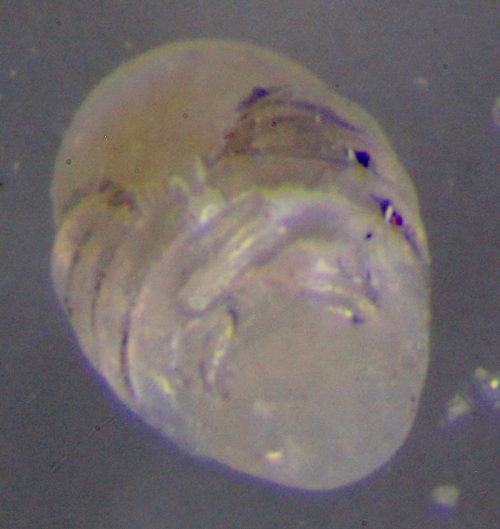Our new development in spider development is pretty basic stuff. We’re dechorionating embryos! That is, stripping off a thin membrane surrounding the embryo, so we can do staining and fixation and various other things. It’s a standard invertebrate technique — it turns out you can remove it by just washing them in bleach. Look, it works! This is a Parasteatoda embryo.
We’re still tinkering with the timing of the treatment. Five minutes is way too long, which basically dissolved the whole embryo. All it takes is a brief wash to break the chorion down. We’re also working out methods for manipulating them — they’re tiny! Just pipetting them into a solution is a great way to lose them. We’re now using a cut off microfuge tube to make a cylinder that we cap with a sheet of fine nylon mesh, to lower them into the solution. Of course, then we have to separate the embryos from the mesh. Fortunately, we opened up one egg sac and 140 embryos rolled out, so we have lots of material to experiment on.
The next question is whether they survive our abuse. We’ve got some of them sitting under a microscope, time-lapsing their response. We’ll see if they grow…or die and fall apart.



“Church of Bleach” family goes to trial, representing themselves in court
Has no one done such work before, or do you have your students re-inventing the arachno-embryology wheel as lab instruction?
No, people have done this before — it’s a fairly standard procedure. We just have to fine tun the implementation details.
If this thing was a hundred times bigger and emitted a greenish light, I would tell Kane to back away.
Don’t they need that?
Friend meyer @ 5
Yes, I think the membrane is there for a reason. Mad scientist doing evil things?
Spell check altered name of Erlend Meyer @ 5.
No insult intended.
None taken.
The membrane is a barrier against bacteria, and may also play a role in maintaining ion balance (but maybe not — that’s not as big a deal in a terrestrial organism). They do fine without it in a clean lab environment, but in nature losing it would turn you into a squishy snack.
I did this years and years ago, with a different species of spider. It stemmed from handling zillions of Drosophila embryos, and I sort of branched out from there to try out a cross-reacting engrailed antibody (I think it was called 4D9, from Nipam Patel). Memories are vague, but I used extra-diluted chlorox, and watched them de-chorionate under a dissecting scope. For me, it did not matter if they were alive bc they were destined for buffered formaldehyde. What happened with the antibody I do not recall, but i suppose it did not work since I would have remembered that.